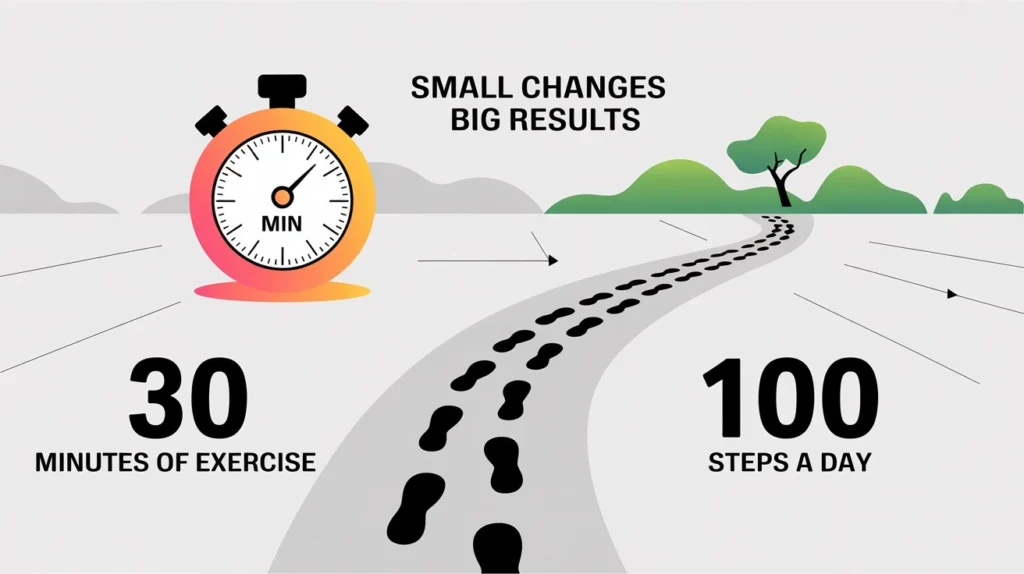In today’s health conscious world, we are constantly bombarded with advice on how to stay fit and active. Two common recommendations are 30 minutes of exercise and 100 steps a day. But, with limited time and busy schedules, many people are left wondering which option is better. Is dedicating 30 minutes to exercise the most effective choice, or is simply walking 100 steps a day enough? Let’s dive into the benefits and drawbacks of each to help you make an informed decision.
The Benefits of 30 Minutes of Exercise a Day
1. Comprehensive Physical Health Benefits:
Exercising for 30 minutes daily offers a wide range of health benefits that go beyond just physical activity. From boosting cardiovascular health to enhancing muscle strength, 30 minutes of moderate-intensity exercise is an effective way to improve overall health. Exercise can help manage weight, lower blood pressure, and reduce the risk of chronic diseases such as diabetes and heart disease.
2. Mental Health Improvements:
Exercise has been shown to reduce stress, anxiety, and symptoms of depression. Regular physical activity stimulates the production of endorphins, the body’s natural mood elevators. Engaging in a 30-minute workout, whether it’s walking, cycling, or doing strength training, can significantly improve your mental well-being.
3. Flexibility and Versatility:
One of the main advantages of 30 minutes of exercise is the flexibility it offers. You can choose from various types of activities such as yoga, weight training, cycling, swimming, or aerobics, each providing different benefits. Whether you’re a beginner or a fitness enthusiast, there’s a 30-minute workout for everyone.
4. High Calorie Burn:
If weight loss is one of your goals, 30 minutes of exercise is far more efficient at burning calories than simply walking. Vigorous activities like running, cycling, or high-intensity interval training (HIIT) can burn far more calories than walking, helping you achieve your fitness goals more quickly.
The Benefits of 100 Steps a Day
1. Easy and Simple to Incorporate:
Walking 100 steps a day is an incredibly simple goal to set, and it’s achievable even for the busiest individuals. Unlike structured workouts, taking steps doesn’t require special equipment or a gym membership. You can easily integrate 100 steps into your daily routine, such as taking the stairs instead of the elevator or walking around your house.
2. Improved Circulation and Energy Levels:
While walking 100 steps a day might not seem like much, it helps stimulate blood circulation and increase energy levels. Short bursts of movement can keep your body more active throughout the day and prevent prolonged sitting or sedentary behavior.
3. Accessibility for All Ages:
One of the greatest benefits of walking 100 steps a day is that it’s accessible to people of all ages and fitness levels. For seniors, individuals recovering from injury, or people just starting on their fitness journey, this is an excellent way to get moving without feeling overwhelmed.
4. Low Impact:
Walking is a low-impact activity that places minimal strain on joints, making it an ideal choice for individuals with joint issues or those new to exercise. It’s an excellent way to stay active without worrying about injury risks.

Comparing 30 Minutes of Exercise vs. 100 Steps a Day: Which Is Better?
1. Time Commitment:
The major difference between the two options is the time required. 30 minutes of exercise will demand more time but offers more comprehensive benefits, including higher calorie burn, improved cardiovascular health, and strength development. On the other hand, walking 100 steps a day is much more manageable and doesn’t require dedicated time slots. If you’re looking for a quick, easy solution, 100 steps may be more practical.
2. Intensity and Results:
While walking 100 steps a day is an excellent starting point, especially for beginners, it lacks the intensity that a 30 minute workout can provide. Exercise that lasts for 30 minutes can challenge your body more, helping you achieve greater results in less time. If your goal is to lose weight, build muscle, or improve endurance, 30 minutes of exercise will be the more effective option.
3. Consistency and Adaptability:
Consistency is key to any fitness routine. Both options can be sustainable, but 30 minutes of exercise offers more variety and the potential to increase intensity over time. You can easily adapt your routine as you progress, increasing the challenge to continue improving. With 100 steps a day, progress may slow down once the habit becomes too easy.
4. Health Goals:
- For weight loss and overall fitness: 30 minutes of exercise is the better choice, as it offers more opportunities for calorie burn and intensity.
- For maintenance of general health: Walking 100 steps a day is an excellent option, especially for those who are starting their fitness journey or looking to maintain low-intensity activity.
Conclusion
Both 30 minutes of exercise and 100 steps a day offer valuable health benefits. If you’re aiming for improved cardiovascular health, weight loss, and overall fitness, dedicating 30 minutes to exercise will likely provide better results. However, if you’re looking for a simple, sustainable habit to stay active throughout the day, walking 100 steps is a great way to start.
Ultimately, the best choice depends on your fitness goals, available time, and current physical condition. Both activities can be incorporated into a balanced, healthy lifestyle, so don’t feel pressured to choose one over the other. Instead, consider starting with 100 steps a day and gradually increasing your physical activity until you’re ready to commit to 30 minutes of exercise for even greater benefits.




